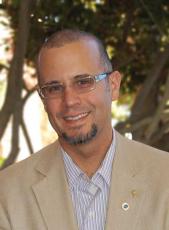Unifying Fields: Science Driving Innovation
Fall
2015
Letter
Unifying Fields: Science Driving Innovation
Introducing the Theme of the 2016 Quadrennial Congress of Sigma Pi Sigma (PhysCon)
By:William DeGraffenreid , Professor of Physics and Department Chair at the University of California, Sacramento, Co‐Chair of the 2016 Quadrennial Physics Congress Planning Committee
University of California - Sacramento
 If you were to ask random people to describe what Silicon Valley means to them in one word, I would venture a guess that answers such as “innovation,” “technology,” “computers,” and “money” would be popular.
If you were to ask random people to describe what Silicon Valley means to them in one word, I would venture a guess that answers such as “innovation,” “technology,” “computers,” and “money” would be popular.
If you were to ask members of the SPS National Council the same question, you might get a different answer: “Congress.”
Sigma Pi Sigma and the Society of Physics Students have begun planning the 2016 Quadrennial Physics Congress. It will take place just outside of San Francisco, CA, a city that has been fundamentally changed by the energy of Silicon Valley in recent years. Drive around the Bay Area and you'll see names like Google and Facebook on the sides of the buildings. The region is a hotbed of movers and shakers, with few peers anywhere else in the world.
This location is a fitting place for the Congress, which brings together physics students, alumni, and faculty members for a high-energy, exciting weekend packed with cutting-edge physics, networking events, and opportunities for personal and professional growth. The location also echoes the theme for the 2016 Congress, around which the program is designed—Unifying Fields: Science Driving Innovation.
In line with that theme, this issue of The SPS Observer brings together examples of how people are using their understanding of physics, and the skills they developed while students of physics, to move our society forward. Meet Ben Perez, an SPS member who spent a summer on an ambitious Google X project that uses balloon-mounted lasers to send and receive data. Read about X-ray innovations coming out of the Stanford Linear Accelerator Center. Hear the story of how exploring frontier physics topics changed the course of SPS alum Sean Bearden’s life. Test your knowledge on some of the physics discoveries that have led to game-changing inventions.
Almost all of the new freshmen physics majors who come to orientation at my university indicate that their goal is to attend graduate school, earn a PhD, and then get a great job at a university or national laboratory. While I know that this is a path that some will follow, I also know that it isn’t for everyone. As you progress through your classes, attend department seminars, read Physics Today and The SPS Observer, and talk to your professors, you will learn about the wide variety of opportunities that exist beyond academia, many of which can catapult you to the forefront of innovation. (For an example, read Sandeep Giri's excellent piece on his own path on page 6.)
Leveraging our understanding of the physical world to push society forward is not new. From fundamental “simple machines” to complex electromechanical systems, the laws of physics have been exploited time and time again to make our lives easier, longer, and better. We hope that you will come to the 2016 Congress and join the conversation about how to continue using science to drive innovation. //
